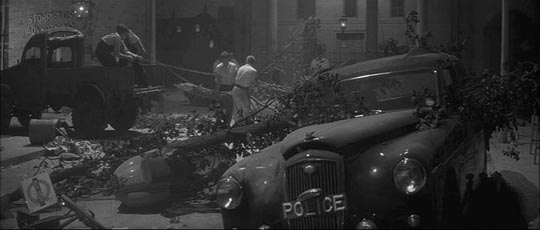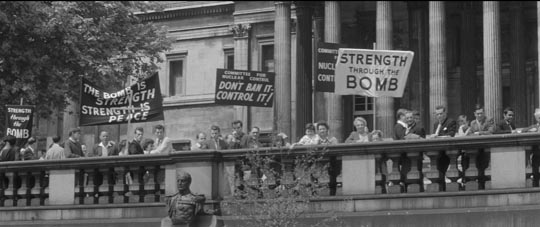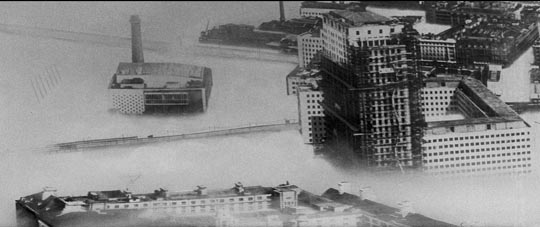Val Guest and The Day the Earth Caught Fire (1961)

I was a fan of Val Guest long before I had any idea who he was. When I was nine or ten, I got to see his Hammer film Quatermass 2 on television – in itself a bit unusual as in England at the time horror films were generally X-rated (that is, restricted to adult audiences). But perhaps Quatermass got a pass because it was, after all, a feature adapted from the original Nigel Kneale BBC serial (1955). I loved it and much of its imagery stuck with me for years, although I didn’t get another chance to see it until it finally turned up on laser disk in the ’90s. So I first associated Guest with horror and science fiction, eventually seeing The Quatermass Xperiment and The Abominable Snowman before catching up with non-SF titles like Expresso Bongo and Hell is a City on DVD.
Guest started his career as a “gag man” for Will Hay comedies at Gainsborough Studios in the ’30s before getting a chance to direct during the war. Throughout the ’40s and into the early ’50s, he made a long string of comedies and musicals – first with Arthur Askey, then Margaret Lockwood, and eventually with Michael Rennie and Yolande Donlan, whom Guest married. This career path shifted crucially in 1954 when Guest was hired by Hammer Films to direct a colour film based on the Robin Hood legend, The Men of Sherwood Forest. Although he did occasionally continue to turn out the odd comedy, he began to concentrate on genre films. When Hammer offered him the task of transforming Kneale’s first Quatermass serial into a feature, he initially had no interest – science fiction wasn’t his thing. But when Donlan urged him to read the television scripts while on holiday, he found the story compelling and decided to accept the job.

His attitude towards the genre indicates little familiarity with its possibilities, seeing it as trivial and juvenile; this resistance actually worked to the film’s advantage, because he was determined to play down the fantastic elements and concentrate on what he deemed a documentary approach. This in turn involved shooting on real locations, giving the film a gritty texture, and on generally naturalistic performances. Commercial considerations resulted in one crucial distortion, which outraged Kneale and caused friction between the original writer and the director: this was the hiring of a borderline has-been American “star” to play the brilliant scientist at the centre of the story. Brian Donlevy roars and blusters his way through the film, somewhat undermining the Englishness of the story while adding a note of imperial arrogance towards the victims of Quatermass’s experiment which gives the film a different but no less effective dramatic power from the original serial. (Despite that rocky start, Guest and Kneale collaborated twice more in 1957, with Guest co-writing the script for Quatermass 2 and directing Kneale’s own adaptation of another of his television projects, The Abominable Snowman.)

The careful attention to character and locations became a signature characteristic of Guest’s subsequent work regardless of the particular genre. His war films – The Camp on Blood Island (1958) and Yesterday’s Enemy (1959) – are harsh and determinedly unheroic, the former depicting life in a Japanese prison camp, the latter (starring Stanley Baker) confronting an atrocity committed by British troops in a jungle village. Stanley Baker also starred in Hell Is a City (1960), an excellent “kitchen sink” drama about a cop in Manchester dealing with a troubled marriage and the hunt for a vicious criminal. Guest maintained a perfect balance between the personal and narrative elements in that film, something he didn’t manage to repeat in 80,000 Suspects (1963), in which a doctor’s personal life tends to overwhelm the story of an attempt to track and contain the outbreak of a highly contagious disease.
Guest himself wrote or co-wrote many of the scripts during his most accomplished period from 1955 up through 1964; he also became a co-producer on most of his later films up through the mediocre espionage effort Assignment K (1967), after which – following a brief return to Hammer for When Dinosaurs Ruled the Earth (1970) – he sank into episodic TV work and Brit sex comedies. But for that one decade, Guest was one of the finest directors at work in England, a fact which tends to remain somewhat invisible because of his focus on genre stories (sci-fi, war, crime) rather than “serious drama”. Even on the BFI’s Blu-ray release of Guest’s masterpiece The Day the Earth Caught Fire, the extras contain a certain amount of faint praise which seems to feel the need to pull the film down to its “proper” level. That annoyance aside, however, the disk is one of the year’s best.

The Day the Earth Caught Fire (1961)
With a script by Guest and Wolf Mankowitz based on an idea Guest had been nurturing for seven years, The Day the Earth Caught Fire is not only one of the finest British science fiction films ever made, it’s also a great newspaper film which ranks with The Front Page and Ace In the Hole. Guest’s obsession with accuracy resulted in the art department (headed by Tony Masters, who went on to work on 2001: A Space Odyssey and David Lynch’s Dune) recreating in minute detail the offices of the Daily Express for the film’s primary set. Guest even hired recently retired Express editor Arthur Christiansen to play editor “Jeff” Jefferson (who comes in for some knocks from some of the disk’s interviewees for his amateur performance, although he really acquits himself quite well).

For an apocalyptic movie about the impending end of the world, The Day the Earth Caught Fire takes a refreshingly different approach from most examples of the genre. It doesn’t focus on the scientists who cause the catastrophe or the other scientists who try to rectify the disaster; it avoids the military and the government officials who so often make up the casts of these films. Instead, in the great British tradition of John Wyndham, John Christopher and their like, it sticks closely to ordinary people – in this case a group of reporters and newspapermen who gradually uncover the story which is already underway as the film starts. Washed-up writer Peter Stenning (Edward Judd) is being carried by his exasperated friend, science correspondent Bill Maguire (Leo McKern), as he sinks into alcoholic depression over the disintegration of his marriage and the estrangement of his young son. Chafing at being given menial assignments like researching sun spots as background for a piece on the inexplicable heatwave sweeping over the country, he meets and aggravates Jeannie Craig (Janet Munro), an employee of the Meteorological Department. The human drama of the story becomes focused on their tentative relationship – Jeannie is a refreshingly independent, unselfconsciously sexual woman who holds her own against the egotistical and initially sexist Stenning, who slowly regains a sense of the value of life just as extinction becomes almost certain.

The mystery element of the story – just what is behind the crazy weather worldwide – is nicely embedded in the story of Jeannie and Stenning and the daily work of the newsroom; once the facts become known (two massive simultaneous nuclear tests by the Americans and Russians have shifted the Earth’s orbit and the planet is heading towards the sun), the focus becomes the progressive breakdown of society and the ways in which these people come to terms with their almost certain deaths. Through well-drawn characters and crackling, fast-paced dialogue, Guest makes it clear what we stand to lose through our own species’ stupidity. And while the basic mechanics of the disaster may be nonsense, the overall theme is undeniably pertinent: what happens abruptly in the film has been occurring in slower motion over decades as we continue to foul our environment through laziness and an obsession with short-term economic gain. The devastating weather patterns depicted in The Day the Earth Caught Fire are now happening for real and the evidence is pretty conclusive that we’re at the root and still too stupid to stop doing the things which are causing the problem.
The disk
In addition to an excellent new 4K transfer, the BFI’s Blu-ray of The Day the Earth Caught Fire is loaded with interesting extras, starting with the audio commentary by Val Guest, whose memory is usefully prodded by critic Ted Newsom (ported over from Anchor Bay’s 2001 DVD, recorded when the director was 90!). Guest was obviously very proud of his accomplishment and very serious about striving for as much verisimilitude as possible.

The Day the Earth Caught Fire
That verisimilitude is, however, questioned in some of the other extras. In particular some of the people interviewed in the retrospective documentary Hot Off the Press: Revisiting The Day the Earth Caught Fire (34:00) point out that the snappy overlapping dialogue in the newsroom owes more to Hollywood movies than to reality; this attitude confuses movie “realism” with reality and seems to forget that the aim of an approach like Guest’s is to convince the audience of the authenticity of the essentially far-fetched events taking place. So, yes, the script, direction and performances play on the idea we have of what hard-boiled newsmen (and yes they are all men) were like. A pedantic attempt to turn these characters into – what? dull cogs in the media machine? – would not necessarily have made for a more “believable” film, but would certainly have made for a less entertaining and involving one.
There is also a tendency among these commenters to feel the need to make excuses for the film’s special effects, which – given the tight budget – are occasionally a bit weak (including some obvious model shots which Guest couldn’t afford to reshoot). But there’s a genuine beauty in many of the matte shots of London beset by climatic devastation – the burned dry Thames, the thick ground fog out of which buildings poke. It’s probably pointless at this stage to try to convince unbelievers that the ancient craft of optical effects offers greater aesthetic satisfaction than the often weightless photorealistic perfection of CGI, but personally I take great pleasure in what could be accomplished by skilled technicians before the advent of computers.

There’s a brief interview with Leo McKern from 2001 (9:00), revisiting some of the film’s locations; an audio appreciation by journalist Graeme Hobbs (9:00); a gallery of stills and promotional material (7:00); and an engaging Q&A with Val Guest (joined part way through by his wife Yolande Donlan) recorded at the National Film Theatre in 1998 (63:00), which covers much of his career, but concentrates mostly on the early years at Gainsborough. At age 86, the director was lively and good-humoured, with clear memories of the people he’d worked with many decades before.
As if all this weren’t enough, the BFI have added extra context by including three public information films from the period to set the scene out of which The Day the Earth Caught Fire emerged. These films set in stark relief the chilling attitudes of the authorities towards nuclear weapons and the Cold War, the kind of blindness to consequences which Guest’s film so chillingly depicts. Operation Hurricane (Ronald Stark, 1952, 33:00) is a gee-whiz documentary about the first British atomic bomb test off the coast of Australia, admiringly detailing the manufacture of the device and all the elaborate preparations for the explosion; the main point being made (apart from asserting English equality on the technical front with the U.S. and USSR) is that possession of the bomb was essential for Britain to have a voice in world affairs. At the end of this black-and-white film there’s an abrupt switch to colour for a replay of the explosion and apparently we’re supposed to feel awe and wonder rather than horror.

The H-Bomb (David Villiers, 1956, 22:00) is just the kind of thing that Peter Watkins so ferociously attacked in The War Game (1965); in an urgent yet matter-of-fact tone, this film lays out everyone’s responsibility for civil defence, equating impending nuclear attack with the Blitz and the necessity for citizens to do their part when disaster strikes. The disparity between the instructions offered and the probable reality of an actual attack is as ludicrous as “duck and cover”, with images of people pulling trapped individuals free of the rubble completely oblivious of the actual consequences of a nuclear blast.
The third short, previously available on the BFI’s sixth volume of Central Office of Information shorts, Worth the Risk?, is the most chilling of all. The Hole in the Ground (David Cobham, 1962, 30:00), dealing with the national network of observers and coordinators set in place to monitor a nuclear attack, is horrifying in its calm technocratic assurance that such a disaster can be managed efficiently thanks to good preparation. What the people in their bunker are monitoring (blast locations, the spread of fallout) is stripped of its actual meaning – that is, millions of dead and dying people – and everyone can take satisfaction in a job well done, even as the second wave of the attack begins …

Apparently on its original release The Day the Earth Caught Fire was greeted with some criticism not so much for its far-fetched initial premise as for its assertion of official incompetence and the way the authorities try to keep the consequences of that incompetence secret from the public. As Jeannie says at one point in the film, the people in charge must know what they’re doing, so we should just trust them and not cause trouble by questioning their actions. That attitude, implicit in The Hole in the Ground and the other two shorts on the disk, is the real target of Guest’s attack and if, in today’s changed media landscape, it seems less likely that a bunch of hard-drinking newspapermen are the ones best able to wage the fight, just look at what’s been unfolding over the past couple of years with WikiLeaks and Edward Snowden. Even today, with our far more sophisticated national security states, the powers-that-be are still vulnerable to exposure … and still just as prone to trying to keep secret the appalling consequences of their own stupid schemes.
Comments